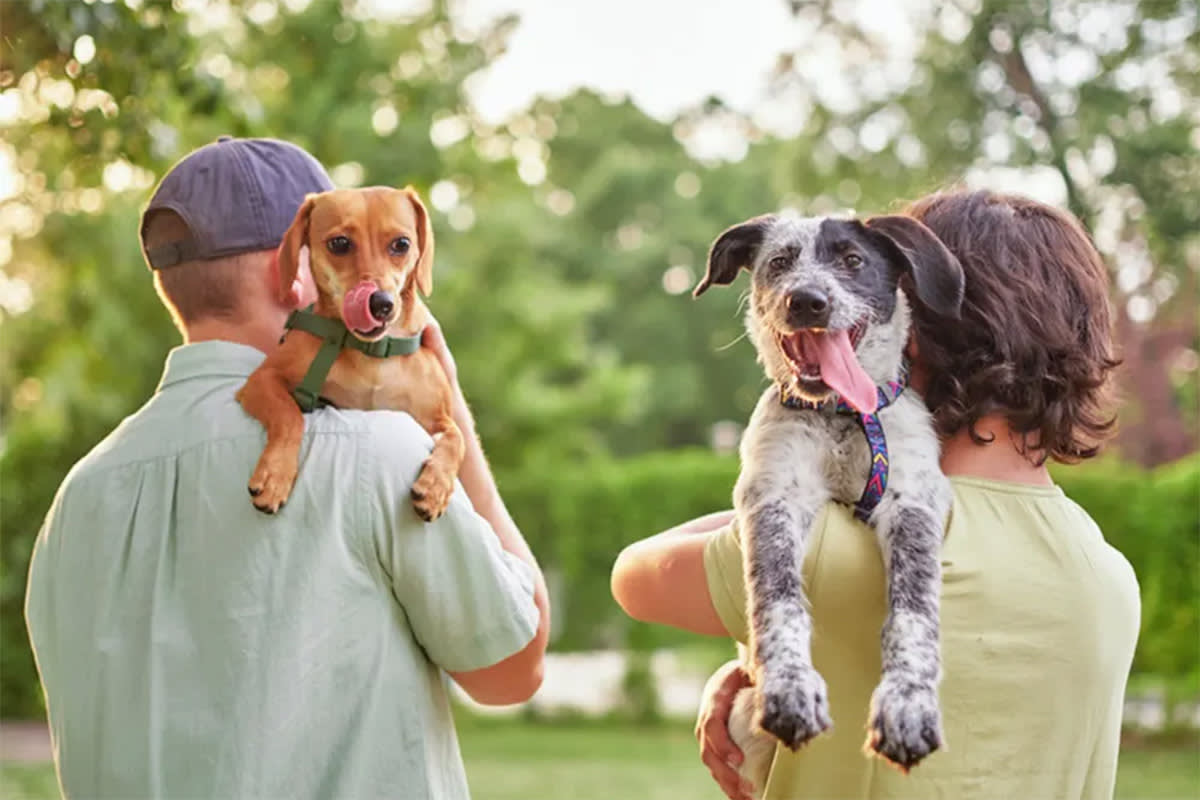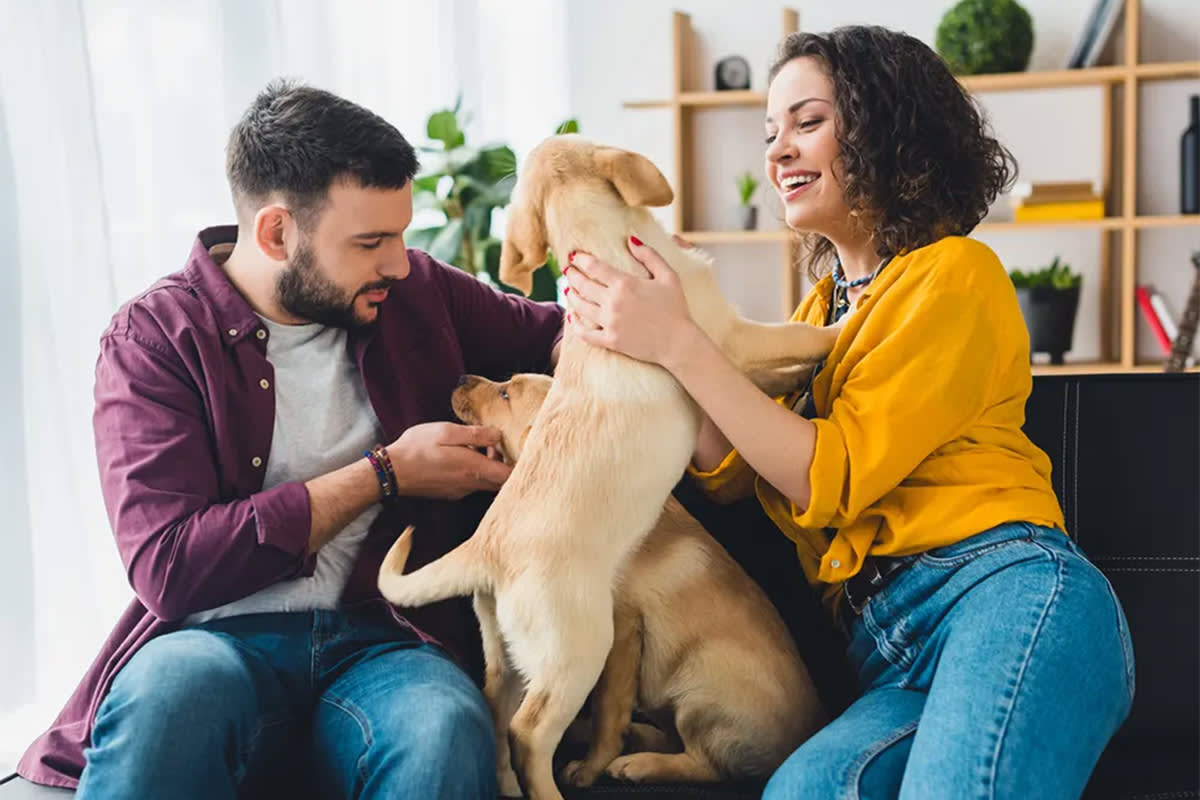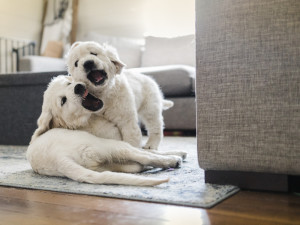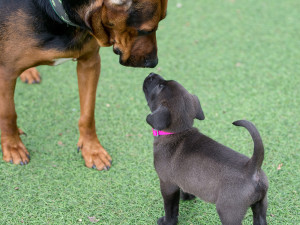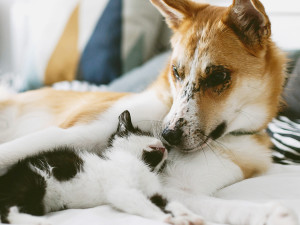4 Signs Your Dog Would Like a Sibling
You want a second dog, but is your pup into the idea?
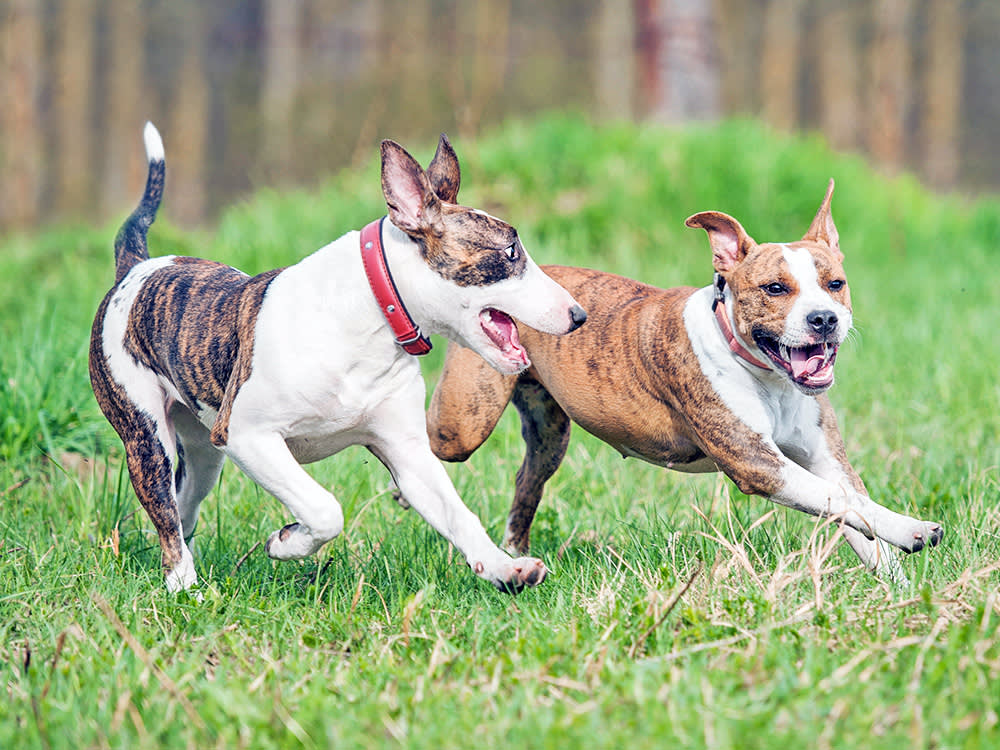
Share Article
Dogs can be a lot like Fritos — and not just because their paws sometimes smell like corn chips. Once you’ve brought one adorable pooch home, it can be very tempting to scoop up another. This is especially true if your current pup seems bored and lonely. Who among us hasn’t wondered if our best pal might want a dog “sibling” to play tug with?
I had this thought a few years ago when my older dog started slowing down. He’s never been much for toys, but he’s very social, so naturally, I figured a younger hound might perk him up. Once I started fostering a puppy, I quickly discovered I was right. He instantly seemed to have more energy — which I took as a sign he’d recovered his zest for life by bonding with his little sister. I felt like a parenting prodigy.
But that’s not always how things go down. In fact, as I began investigating this topic, both experts I consulted offered several reasons to think long and hard before bringing home a new companion.
Research suggestsopens in new tab that dogs who share a household with another canine may be healthier than those who don’t. At the same time, veterinary behavior and welfare specialist Dr. Valarie Tynes cautions that not all dogs want or know how to make friends with their own kind. In fact, she says, “There are an awful lot of dogs out there that have absolutely no interest in interacting with other dogs.”

Before you bring home a sibling for your dog, it’s crucial to make sure that you actually want a second dogopens in new tab. Once you’ve determined that, you’re on to the next, equally important step: making sure your dog actually wants a sibling, too. Both experts caution that there’s no universal “sign” for this, but there are, at least, a few green flags.
How can I tell if my dog wants a sibling?
All dogs are different, so as pet parents, all we can do is pay close attention to their behavior and make decisions accordingly. Do your homework on dog body languageopens in new tab to learn the signs of fear, frustration, and stress. That way, you’ll have a better understanding of how your pup feels around other dogs. Then, watch for these encouraging signs.
They know how to act around strangers.
If your dog has never cohabitated with another canine before, consider how they act with the ones they encounter in the wild.
Jill A. Goldman, Ph.D., M.Sc, certified applied animal behaviorist and owner of DJG Animal Behavior Servicesopens in new tab, suggests watching closely as your dog interacts with new acquaintances and asking yourself questions like, How [do they] interact with dogs that they would see on the street? Do they care? Do they want to play? Do they not want to play? Are they aggressive?
If your dog seems upset or aggressive when crossing paths with another pooch, they probably don’t want one living in their home, either. But if they get excited, that could be a positive signal.
The key in this process is not to assume anything. If you haven’t seen your dog interact with many dogs, Tynes says, “I would start with hanging around with other dogs, and whenever safely possible, to see if the dog really seemed to have an interest in playing.”
And if you suspect your dog is not well socialized — meaning, they don’t know how to positively interact with other dogs — this is not a time to experiment. Make sure your dog is properly socialized before you consider bringing a new dog into the home.
They love hanging out with other dogs.
Being nice to strangers is one thing. But does your dog like socializing enough to hang out with another dog all the time?
A dog’s age can be an important factor here, especially when it comes to compatibility. An older, slower dog who isn’t enthusiastic about play might not love hanging out with a puppy who just wants someone to chase.
Sometimes, Tynes meets with clients who see their aging dog slowing down and believe that another dog will help keep them company. The problem? In some cases, she says, “that aging dog doesn’t want a puppy bugging him all day long and harassing him.”
If your dog is social but doesn’t love playing, don’t force it. This could be your sign to see how they do with a less active roommate — one who enjoys moving at the same speed.
They’ve enjoyed having a sibling before (and are ready for a new one).
If your dog has enjoyed living with another pup in the past, it stands to reason that they could enjoy a similar arrangement in the future. But once again, it’s important not to make assumptions.
Dogs’ relationships can be just as unique and special as humans’, so dogs who’ve recently lost a longtime pal might need a little time before they’re ready to welcome a new one. There’s also a chance that they don’t want a new friend.
“Just because a dog has interacted with one dog its whole life, that doesn't mean it's going to be open about interacting with other dogs,” Tynes says. “It's not necessarily completely translatable from that dog to the next.”
Her advice? Instead of immediately bringing a new dog home, watch your dog engage with other dogs in more casual settings — like with a friend’s dogs who like to socialize. That way, you can gauge how interested your dog is in making a new lifelong friend before committing.
They get along with the new dog you’re thinking of bringing home.
As important as it is to confirm that your dog actually wants a new sibling, it’s also worth making sure they actually want this sibling that you’re thinking of bringing home. Finding the right doggie dynamic starts with finding a compatible dog.
“Just like people,” Goldman says, “not everybody gets along with everybody. Not everybody likes everybody.”
To figure out if your dog might have chemistry with another dog, Goldman suggests thinking like you’re on a dating app: “Do they like the same things, or do they have a similar temperament? Are they chill, or are they hyped up? Can they balance one another?”
If you’re able to foster, that’s the best way for both you and the dogs to test the waters. It’ll give you a front-row seat to watch the two pups interact over a longer period of time, and it’ll also give you the opportunity to make sure you’re ready for a second dog. (Of course, assure that fostering is the safe, right fit for your current dog before you take this on.)
“As a behaviorist, I see the cases that don’t work,” Tynes says. “Somebody thinks their dog needs a companion, and they bring a dog home, they don’t get along, and now they’re fighting. The owner loves both of them, but these dogs don’t like living together. And that’s really sad.”
One thing that probably won’t work? Bringing your dog with you to the shelter to find a new sibling. Both dogs will be stressed during their first meeting, and neither will act like themselves. “Sometimes it works, and then you go home and it doesn’t,” Tynes says. “That’s why I think fostering is such a great idea, because you can try to manage the introduction. You can give them time.”
How do I introduce my new dog to my current dog?
Once you think you’ve found the perfect new family member, it’s time to make sure they get along with your current dog. Before you dive in, brush up on your dog body language and recruit a friend or family member to help you. From there, it’s a three-step process:
Meet somewhere neutral and enclosed, where neither dog will feel territorial and you don’t need to hold their leashes
Keep a leash attached to the dogs’ collars and let them approach one another
Drop the leashes as soon as you can so that the dogs can interact freely (but leave the leashes on so that you can pull the dogs away from one another if needed)
If the first meeting goes well, you can take the dogs for a “co-walk,” where you and your helper take them for a walk side by side. During these walks, Tynes says, “[The dogs] need to both be enjoying themselves — not straining at the other dog, not barking, not unable to focus on their walker.”
For the first few days or even weeks, try not to leave your dogs unattended together. If the dogs are crate-trained, you can crate them while you’re away. If not, you can either keep them in separate rooms or use barriers, like baby gates.
As your dogs settle in, avoid treating them as a pair. That way, you can ensure that you’re maintaining a rewarding and healthy relationship with each dog. According to Goldman, “No matter how many dogs you have in the household, you do need to treat them individually — one-on-one, time, one-on-one training, one-on-one attention — in addition to being a family. Because you do still need to focus on the bond that you have with that individual dog.”
If you get a dog that starts to bully and intimidate and create stress and anxiety with the other dog, Goldman says, then a credentialed behaviorist will need to intervene. The relationship may not work. At the same time, there’s a difference between a one-off skirmish and an ongoing dynamic. “If a dog has a fight with another dog, it doesn't necessarily mean that it’s game over,” Goldman says. “They can reconcile.” That’s why it’s crucial to watch your dogs closely and see how their relationship unfolds.
Bringing someone new into the home is always an adjustment, but if you stay attuned to your dogs’ wants and needs, you can spend less time worrying and focus on having fun and making memories as a family.

Laura Bradley
Laura is a New York-based experienced writer and mom of two rescue pups. Her work has appeared in Slate, Vanity Fair, Daily Beast, The Washington Post, The Atlantic, Yahoo! News, Vulture, Grazia Magazine, and more. When she is not writing or walking the pooches, you will probably find her in the community garden.
Related articles
![2 dogs playing]()
Does Your Dog Have Littermate Syndrome?
If you adopted puppy siblings — and they fight nonstop — you could be dealing with littermate syndrome. Here’s everything you need to know.
You Consider Your Dog a Part of the Family—But Do They See You the Same Way?
Experts say pups definitely know who’s in their “group.”
![Big dog meets little brown puppy for the first time]()
Getting a Second Dog?
Use these tips before making the big decision.
![A man in a sweater holding two small dogs in his arms with a pensive look on his face]()
How to Ditch Your Guilt Over Getting a Second Dog
Change is hard, but that doesn’t mean you should feel bad.
![dog and cat snuggling together]()
Animal House: How to Intro a New Dog to Your Other Pets
...Without turning your home into a circus.
